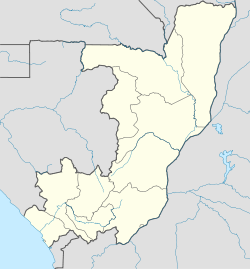
Pointe-Noire
Background to the schools Wikipedia
SOS believes education gives a better chance in life to children in the developing world too. Visit the SOS Children website at http://www.soschildren.org/
| Pointe-Noire | |
|---|---|
|
|
|
| Coordinates: 4°48′S 11°51′E | |
| Country | |
| Department | Pointe Noire Department |
| Commune | Pointe-Noire |
| Population (2005) | |
| • Total | 663,400 |
Pointe-Noire is the second largest city in the Republic of the Congo, and an autonomous Department since 2004. Before this date it was the capital of the Kouilou region (now department). It is the main commercial centre of the country and has a population of 663,400 (2005 census). It is situated on a headland between Pointe-Noire Bay and the Atlantic Ocean.
Climate
The climate is hot and humid. September and October experience somewhat less rainfall than other months.
Structure
Pointe-Noire is a commune divided into six urban districts (arrondissements):
- Patrice Emery Lumumba district, the oldest area. It is the administrative and commercial centre:
- Mvou-Mvou;
- Tié-Tié, the most populous area;
- Loandjili district;
- Mongo-Pokou district;
- Ngoyo district
Economy
Pointe Noire is the essential centre of oil industry in Congo-Brazzaville, one of the main oil producers in Central Africa. Congolese oil has been largely exploited by the French company Elf Aquitaine since its discovery around 1980.
Pointe Noire is also known for its fishing industry.
Formerly, Pointe Noire was home to a potash exploitation which led to the construction of a wharf, currently closed to the public.
Pointe Noire is twinned with the French city of Le Havre.
Transport
Pointe Noire is home to Agostinho Neto Airport, one of the most frequented international airports in the country.
Pointe Noire is also the terminus of the Congo-Ocean Railway, the railway station being a notable building. Thanks to her growth, the city now includes Tié-Tié Railway Station and Loandjili Railway Station, the next railway stations after Pointe Noire terminus.
Pointe Noire has a taxi-bus network that runs throughout the entire city.
Attractions
Pointe Noire's main attractions are its beaches, known for surfing.
History
Pointe Noire's (Black Point) name originated from Portuguese navigators who saw a block of black rocks on the headland in 1484. From then on, Pointe Noire, called Ponta Negra, became a maritime reference, and then a small fishing village from 1883, after the French signed a treaty with local people, Loangos.
In 1910, the French Equatorial Africa (Afrique Equatoriale Francaise (AEF)) was created, and then-French companies were allowed to exploit the Middle Congo (modern-day Congo Brazzaville). It soon became necessary to build a railroad which would connect Brazzaville, the then-terminus of the river navigation on the Congo River and the Ubangui River, with the Atlantic coast. As rapids make it impossible to navigate on the Congo River past Brazzaville, and the coastal railroad terminus site had to allow the construction of a deep-sea authorities chose the site of Punta Negra instead of Libreville as originally envisaged. Constructions of the Congo-Ocean Railway began in 1921, and led to the foundation of Pointe Noire on 22 May 1922.
Development of the city
In 1927, drinking water became available in the city, which had about 3,000 inhabitants. The airport was built in 1932. In 1934, Governor Raphael Antonetti inaugurated the Congo-Ocean Railway. The first hospital was built in 1936. That same year, Bank of West Africa (BAO) opened its first branch in the city. In 1942, the Pointe Noire Harbour welcomed the first ship, and made the city the AEF's seaport.
In 1950, Pointe Noire had 20,000 inhabitants, and became the capital of the Middle Congo, while Brazzaville was the capital city of the AEF. In 1957, the Middle-Congo became the Republic of Congo, although it was not still independent. Incidents which occurred during 1958 legislative elections led the Union Démocratique pour la Défense des Interets Africains (UDDIA) [Democratic Union for the Defence of African Interests] leaders to transfer the capital to Brazzaville, since Pointe Noire was under the influence of political opposition.
Pointe Noire continued growing, and was the most modern city in 1960, when Congo gained independence. Then, the oil discovery around 1980 re-attracted people and factories ( Elf Aquitaine). The population doubled by 1982, and reached 360,000 in 1994.
Civil wars in 1997 and 1999 caused an influx of refugees from the surrounding provinces ( Lekoumou, Niari, Bouenza, Pool) towards Pointe Noire, causing the population to climb to 1,000,000 inhabitants.
Port
- 10.46m draft
Rankings
In the Mercer (consulting firm) Quality of Living Survey of 215 cities; Pointe Noire is ranked 209 in 2009. The rank for 2008 was 210.


